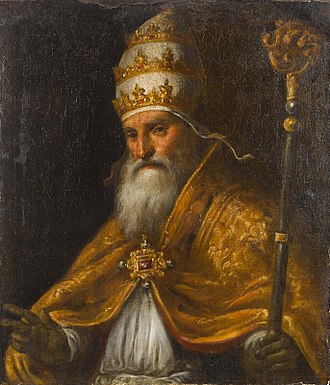Michel Ghislieri was born as Anton in 1504, but took the name of the Archangel ‘who is like God’ when he joined the Dominican Order at the age of 14, and never looked back. Fitting, for his whole life was a spiritual battle, first, against his own sinful tendencies – against which he was merciless, and which should always be our first concern – and then against those external disorders ravaging sixteenth century Europe and even the Church – moral laxity, sexual licence, homosexuality amongst the laity and even the highest members of the clergy; liturgical disorder; heresies, rebellions and revolutions against the truth and goodness; and the threat of Islam, as embodied in the militaristic Ottoman Turks, set to overwhelm Europe. What is old is new again.
We should see stern attitudes in this light: It was a war to the death. Hence, as sometime master of the Inquisition, using coercive methods with which we would now demur, his intention was to bring others back to the truth, and, by the standards then customary, the Inquisition was a fair and balanced court. Far more coercive and unjust were the methods used outside the Church – the agents of Queen Elizabeth and others – who used debilitating and crippling torture. Pius was later to excommunicate Elizabeth in 1570 as a heretic by the decree Regnans in Excelsis – a controversial decision, as it led to the full-blown persecution of Catholics as potential traitors. But God has His ways that are not our, ways and martyrdom is not a bad way to enter eternity.
But political power and potentates were never Father Michel’s primary focus, which was always of the things of heaven, prayer, meditation, recollection, study and focus upon God and eternity. His goodness and discipline, although oft resented as he moved up the ranks of the Dominican Order and the Church’s hierarchy, were widely recognized, and people desired a reformer – nay, even a saint – to save them from the chaos into which the world was sliding.
He was elected Pope in the conclave of 1566, with the support of the influential cardinal Charles Borromeo. He was the fifth to take the name Pius, and reigned until his death on the first day of May, 1572.
His discipline did not abate in what was then the luxury of the post-renaissance papal court. Pius imposed a more holy and serene – even monastic – environment in the Vatican, Rome, Italy and beyond. With a hairshirt under his white Dominican habit, he was oft seen barefoot, living in simplicity, immune to corruption, and no respecter of persons due to their rank or privilege.
It was Pius’ task to implement the decrees of the Council of Trent, which had wrapped up three years before his election. He reformed the Liturgy, promulgating the Roman Missal, which was to be used universally, with little revision, until Pope Paul VI’s reform in 1969 (and more on that in other posts). He also began the process of codifying the Latin Vulgate – which would come to fruition under his successors Sixtus and Clement – as well as the Breviary, and, not least, the Catechism of the Council of Trent, known as the ‘Roman Catechism’, the first universally binding summary of Christian Doctrine, and still an invaluable and authoritative resource. He canonized his fellow Dominican Thomas Aquinas, and advocated that his theology be taught, as the Doctor Communis, or universal teacher of the Church. And Pope Pius funded and supported the crusade against the onslaught of the Islamic Turks, praying as Don Juan led the battle of Lepanto on October, 7th, 1571. He saw by heavenly vision the victory, giving thanks to God, and instituting the feast of the Holy Rosary in thanksgiving, to be celebrated on that day ever since, the prayer to which he attributed the miraculous triumph, which saved Europe from Muslim conquest – for a time, perchance.
Saint Pius stood in the breach, like Moses of old, interceding for and defending the people over which God gave him charge, and fulfilled his duty to the end. He died in 1572, the year after Lepanto, leaving a memory of what a saint can do in the papal chair – as Christ’s Vicar, quite literally moving heaven and earth. He was canonized by Pope Clement XI on May 22nd, 1712, and his remains reside, quite appropriately, in the highest church dedicated to Our Lady, Santa Maria Maggiore, where Pope Francis was also recently laid to rest. They were two quite different successors of the fisherman, but shared a devotion to the Virgin, perhaps also in their own particular ways. We may trust that God works somehow, in some way, through them all.
Saint Pius V, ora pro nobis! +


